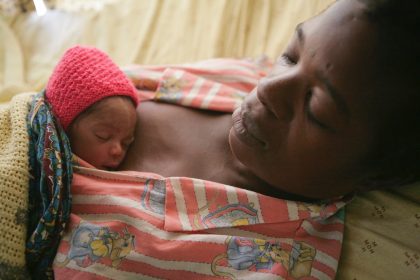Studies show men in polygamous marriages get less involved due to competition, jealousy and mistrust between co-wives. Single mothers can use brothers, uncles or engage proactively with healthcare providers.
The grief in Victor Ambula’s eyes is telling; a gnawing wound that may never fully heal. Early last year, Ambula lost his wife to postpartum haemorrhage – severe bleeding – shortly after she gave birth to their third daughter at a private facility in Kitengela in October 2024.
Trouble began during pregnancy when an ultrasound revealed his wife, Mama Jeremy, had placenta praevia – a condition where the placenta covers the cervix, causing bleeding.

The exact cause of placenta previa is unknown, but it is more common in women who have had similar prior conditions, C-section or other uterine surgery, multiple pregnancies, fertility treatments, smoked or used cocaine, or were over 35.
Ambula’s wife thus needed a Caesarean section for safety. Ambula was involved throughout, attending every antenatal clinic and choosing what he thought was a suitable hospital.
“The hospital was unprepared because from what I later learned, placenta praevia should be handled at a level five or level six because the probability of over bleeding or going to the Intensive Care Unit (ICU) is high,” Ambula says, his voice heavy with pain of powerlessness. “I am not sure if whoever took her to surgery was qualified or not.”
The medics simply told him his wife had died from postpartum haemorrhage as they handed him his little girl, who would be going home without a mother. And though Ambula was proactive throughout his wife’s pregnancy, things still went wrong during delivery.
I helped with house chores that involved bending, and she got the largest share of the bed
For Willys Kasule, a radiographer who was equally involved in his wife’s pregnancy, things turned out differently as he had a professional understanding of pregnancy risks. “My wife Miriam is not a medic, so I felt a duty to ensure she was not led astray by misinformation, and that we could make the best decisions together.”
Kasule accompanied Miriam to all her antenatal clinics, often finding himself the only man in the room. This didn’t deter him. “One exciting bit about involving myself was taking evening walks with my wife to help her do some exercise, help with house chores that involved bending, and of course, she got the largest share of the bed,” says Kasule.
Miriam appreciated everything, saying, “It was exciting to have him visit the clinic together because he was learning the art of fatherhood through the process.” She believes men should be treated as individuals “because there are some that want to be involved” and that not all men are disinterested in pregnancy issues.
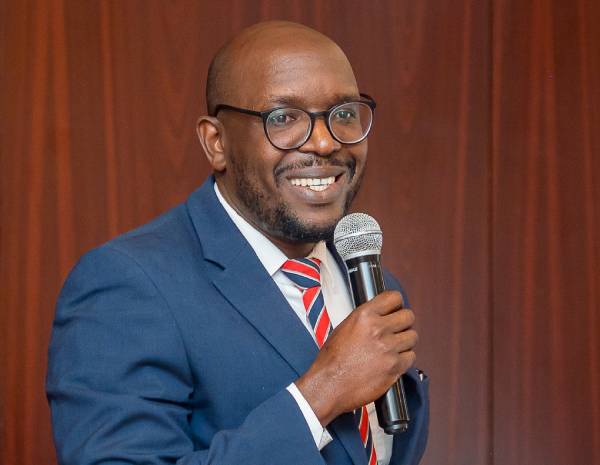
Lawrence Omondi, founder of the Men in Maternity Movement and Machozi ya Mwisho Initiative, sees the tragic consequences of male disengagement firsthand. His organisation advocates against maternal mortality after he lost one of his twins after delivery.
When Omondi asks bereaved husbands about their wives’ deaths, he often gets blank stares as all most know is that “The wife was pregnant and died while giving birth”, and this lack of knowledge makes it difficult to help them get legal or social support.
Men’s perceived role is primarily financial provider, not childcare or household chores
Cultural taboos pegged on masculinity and status create major barriers. In many communities, including the Kuria in Migori County and the Digo along the coast, pregnancy and childbirth are considered women’s domain, as is the case in parts of Western Kenya, where men are principally decision-makers who are hardly socialised into pregnancy or childcare.
Men’s perceived role is primarily financial provider, not childcare or household chores and those involved in “women’s work” face ridicule, while showing public care for a pregnant wife can be deemed as weakness or being controlled by his wife.
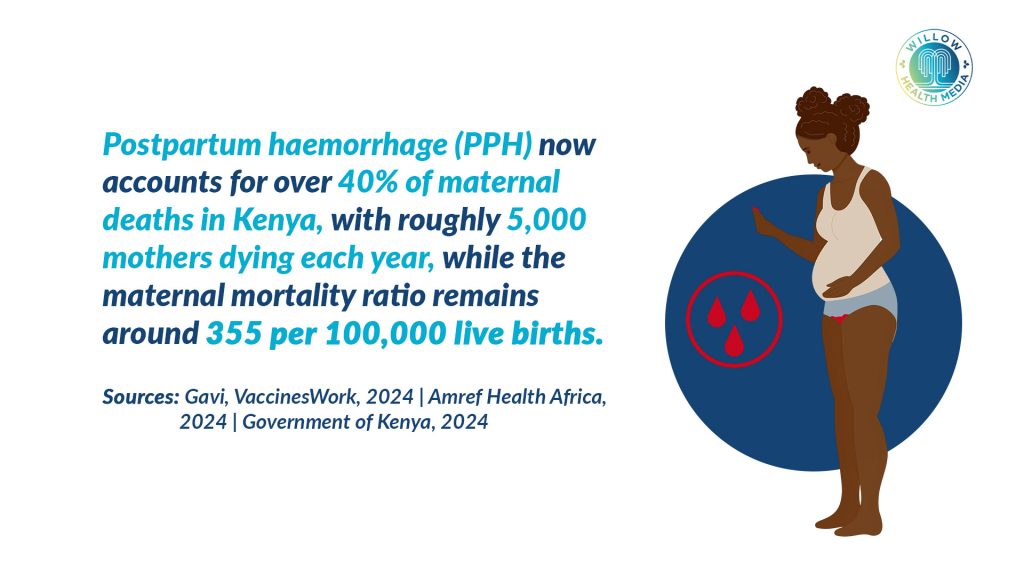
Several studies, including Determinants of Male Partner Involvement in Promoting Deliveries by Skilled Attendants in Busia, Kenya, by Wanjala and Wamalwa and published in Global Journal of Health Science in 2012, found that men face barriers to being involved in maternal health. These include fear of being ridiculed, long wait times at clinics, and a lack of services designed for men, while 2023 research in Kuria East revealed a disconnect between individual men’s positive views and negative community perceptions when they get involved.
The 2019 Kenya National Census estimated the maternal mortality ratio at 355 deaths per 100,000 live births – about 5,680 annual maternal deaths, with postpartum haemorrhage accounting for 34 per cent of these deaths.
Yet, a 2021 study in Kisii and Kilifi counties on joint decision-making about women’s health by Adhiambo A.M. and others showed that when men are engaged, it improves family relationships and decision-making, especially on family planning.
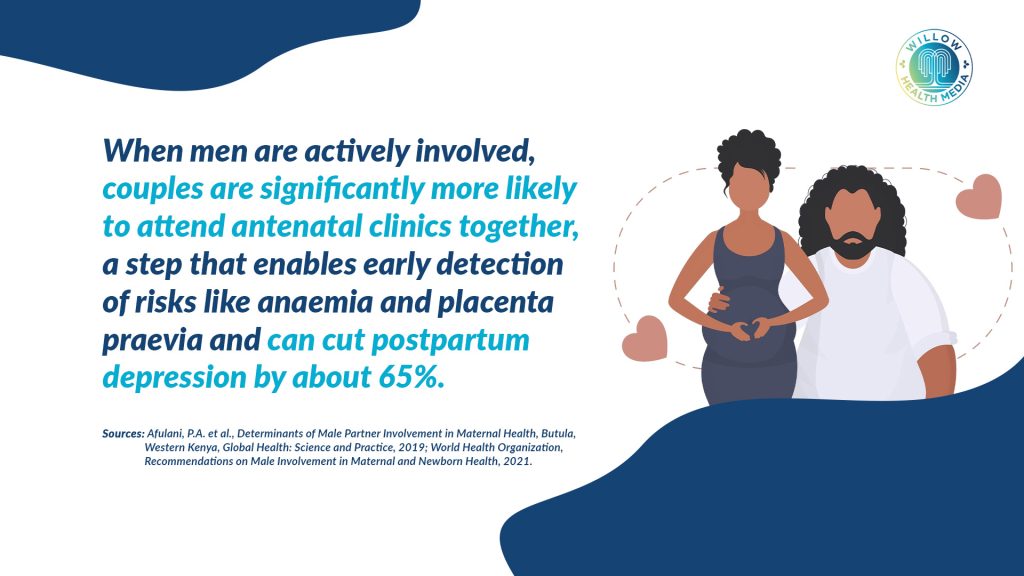
Men can demand necessary care, facilitate urgent transfers to better-equipped facilities
Indeed, a 2019 study in Butula, Western Kenya, by Afulani, P. A. and others showed that when men are involved, couples are more likely to attend antenatal care (ANC) clinics together. At these visits, healthcare providers can identify risk factors for PPH, such as anaemia or a low-lying placenta, allowing for early intervention.
Involved partners also contribute to birth planning – saving money, identifying hospitals, and arranging transport. During emergencies like postpartum haemorrhage, men can advocate for their wives, demand necessary care, and facilitate urgent transfers to better-equipped facilities.
Dr Kireki Omanwa, a gynaecologist and President of the Kenya Obstetrical and Gynaecological Society (KOGS), is blunt about the crisis: “Women are not dying from unknown diseases. We know what is killing them and their newborns, but we have not made a deliberate decision to save their lives.”
Dr Omanwa points out that mothers often die in ambulances on the way to referral hospitals because the vehicles are poorly equipped. A properly equipped maternity ambulance should have blood transfusion kits with a portable cooler, IV fluids, oxygen, and medications to control bleeding. It must also be staffed with a trained midwife or paramedic who can manage emergencies during transport.
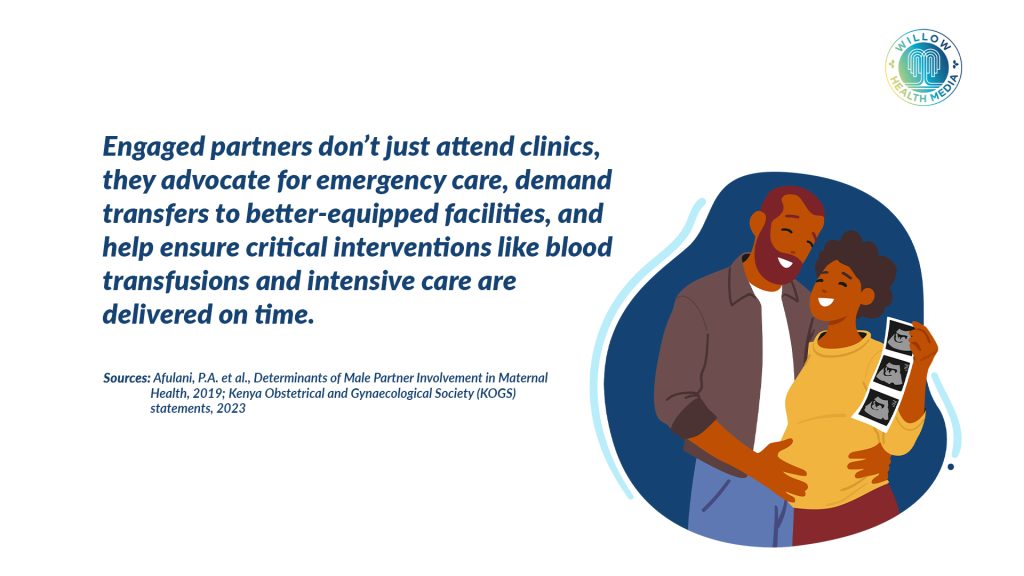
Prof Moses Obimbo, KOGS Secretary, identifies the core issue: “The problem is not lack of knowledge, but a failure to deliver the right quality of care.”
In rural areas, male involvement is critical due to distance to health facilities, lack of transport
A 2021 study in Frontiers in Public Health found that men’s low awareness of pregnancy danger signs is a major barrier. These signs include vaginal bleeding, convulsions, severe headaches with blurred vision, high fever, severe abdominal pain, fast or difficult breathing, and reduced foetal movement. The research showed men often prioritise breadwinning over health activities they perceive as women’s work.
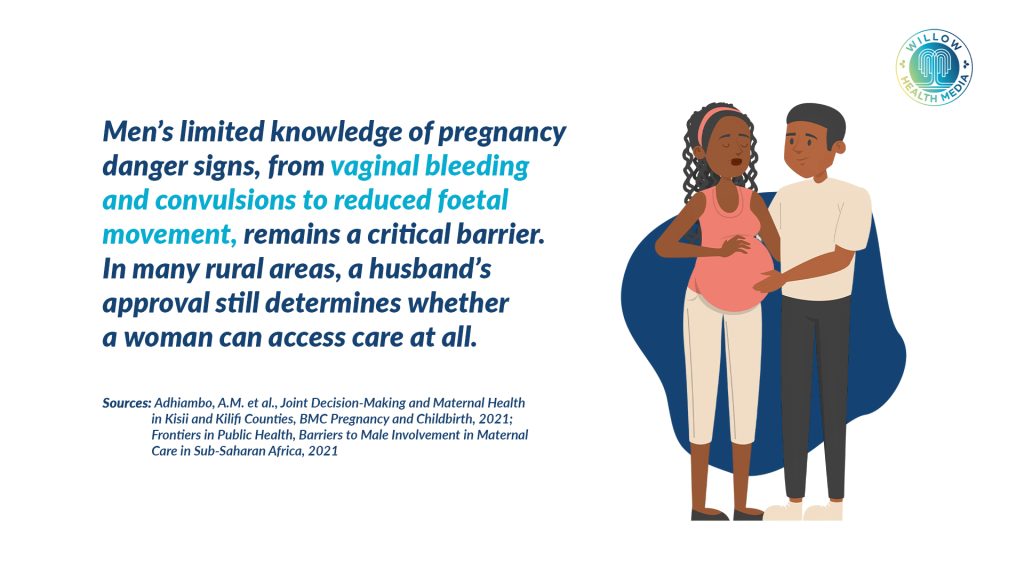
In rural areas, male involvement is critical due to distance to health facilities, lack of transport, and cultural norms. A supportive partner can provide funds, arrange travel, and validate clinic visits. For many rural women, a husband’s approval determines whether they can access care.
Urban areas present different barriers – economic constraints, work schedules, and lack of spousal support. Here, supportive partners provide financial means, accommodate schedules, and take on household responsibilities.
Gladys Mahugu, officer in charge of Maternal and Child Health at Kiambu Level 5 Hospital, encourages male attendance by giving couples priority to reduce wait times. Though she sees only “maybe a maximum of five out of 50 patients in a day”, their presence is transformative.
Joint couple education helps men understand labour and danger signs, making them pregnancy overseers alongside doctors. A knowledgeable man helps with nutrition to prevent anaemia, recognises complications, and knows what to do in emergencies.
The antenatal booklet is not male-friendly and needs to be redesigned for men
The World Health Organization (WHO) has formally recognised this since the mid-1990s, recommending interventions such as couple-focused services, male-friendly health services, educational campaigns, and community engagement that promote men’s involvement as partners and fathers.
Strategic interventions include:
- Community programmes to change cultural perceptions
- Extended paternity leave (currently two weeks under the Employment Act)
- Separate antenatal clinics to encourage male attendance
- Male-friendly antenatal booklets
Kasule advocates for longer paternity leave: “probably a month, because there are just a lot of things to be done at home after the baby is born that require the man’s presence and involvement.”
“The antenatal booklet is not male-friendly; it needs to be redesigned to have men take part actively in the maternity process,” he asserts.
A 2021 study titled, Polygamous marriage and its health implications for mothers and children, published in Frontiers in Public Health, showed that women in polygamous marriages face additional challenges, with men less involved due to competition, jealousy and mistrust between co-wives, which limits communication. Single mothers, on the other hand, can bridge the gap by building strong support networks and engaging proactively with healthcare providers.
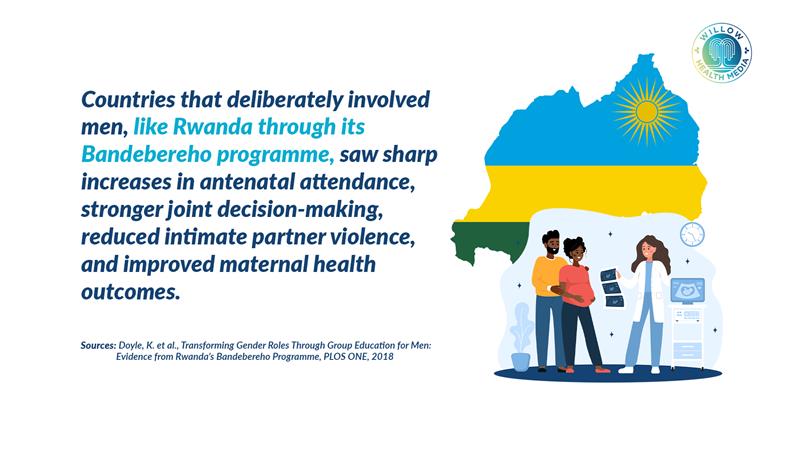
Countries like Sweden and Rwanda demonstrate successful male engagement strategies. Sweden replaced maternity leave with gender-neutral parental leave in 1974. Parents get 480 paid days total, with 90 “use-it-or-lose-it” days reserved for each parent. This has improved mothers’ post-birth health and labour market position.
Rwanda’s “Bandebereho” programme (meaning ‘Role Model’) provides group education for expectant fathers. Studies show it significantly increased antenatal care attendance, improved joint decision-making, reduced intimate partner violence, and improved maternal health outcomes.
Dr Omanwa says KOGS is “dedicated to supporting pregnant women by advocating for quality maternal healthcare and empowering families and healthcare workers with the knowledge and tools they need to prevent complications like PPH to prevent tragic outcomes.”
Prof Obimbo emphasises the preventable nature of these deaths: “Postpartum haemorrhage is preventable, and it is treatable, so no one should die because of this particular condition.”
The solution requires deliberate action – ring-fencing funds for maternal care, improving hospital infrastructure, and recognising that engaging men isn’t just beneficial but essential for saving mothers’ lives.
















